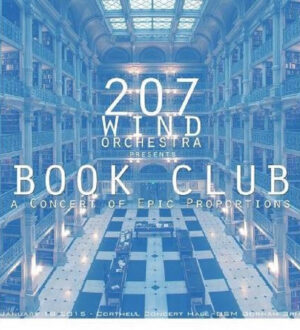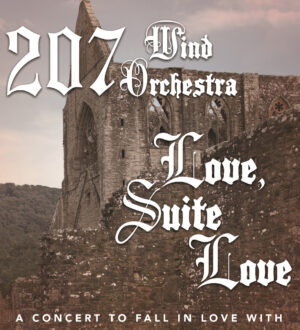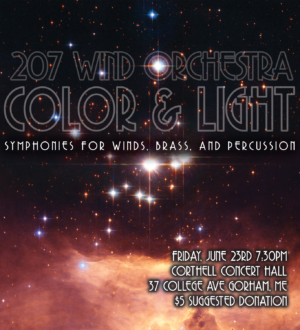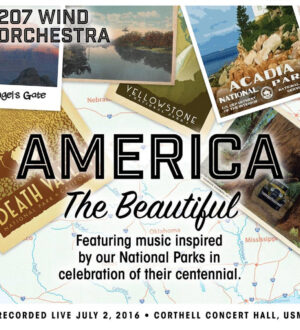Description
Fanfare for the Uncommon Woman, No. 1 was inspired by Copland’s Fanfare for the Common Man and employs, in fact, the same instrumentation. In addition, the original theme resembles the first theme in the Copland. It is dedicated to women who take risks and who are adventurous. Written under the Fanfare Project and commissioned by the Houston Symphony, the premiere performance was on January 10, 1987, with the Houston Symphony, Hans Vonk, conductor. This work is dedicated to the conductor Marin Alsop.
–Joan Tower
Joan Tower is widely regarded as one of the most important American composers living today. During a career spanning more than fifty years, she has made lasting contributions to musical life in the United States as composer, performer, conductor, and educator. Her works have been commissioned by major ensembles, soloists, and orchestras, including the Emerson, Tokyo, and Muir quartets; soloists Evelyn Glennie, Carol Wincenc, David Shifrin, and John Browning; and the orchestras of Chicago, New York, St. Louis, Pittsburgh, and Washington DC among others. Tower was the first composer chosen for a Ford Made in America consortium commission of sixty-five orchestras. Leonard Slatkin and the Nashville Symphony recorded Made in America in 2008 (along with Tambor and Concerto for Orchestra). The album collected three Grammy awards: Best Classical Contemporary Composition, Best Classical Album, and Best Orchestral Performance. In 1990 she became the first woman to win the prestigious Grawemeyer Award for <span “mso-bidi-font-weight:=”” bold”=””>Silver Ladders, a piece she wrote for the St. Louis Symphony where she was Composer-in-Residence from 1985-88. Other residencies with orchestras include a 10-year residency with the Orchestra of St. Luke’s (1997-2007) and the Pittsburgh Symphony (2010-2011). She was the Albany Symphony’s Mentor Composer partner in the 2013-14 season. Tower was cofounder and pianist for the Naumburg Award winning Da Capo Chamber Players from 1970-1985.
New England Triptych – Three Pieces for Orchestra after William Billings, originally for orchestra, was freely transcribed for concert band by the composer. These pieces do not constitute a “fantasy” on themes of Billings, nor “variations” on his themes, but rather a fusion of styles and musical language. Billings’ text for the anthem Be Glad Then, America includes the following lines:
Yea, the Lord will answer
And say unto his people — behold
I will send you corn and wine and oil
And ye shall be satisfied therewith.
Be glad then, America,
Shout and rejoice.
Fear not O land,
Be glad and rejoice.
Halleluyah!
A timpani solo begins the short introduction, which is developed predominantly in the lower winds and brass. This music is suggestive of the “Hallelujah” heard at the end of the piece. Trombones and trumpets begin the main section, a free and varied setting of the words “Be Glad Then, America, Shout and Rejoice.” The timpani, again solo, leads to a middle fugal section stemming from the words “And Ye Shall Be Satisfied.” The music gains momentum, and combined themes lead to a climax. There follows a free adaptation of the “Hallelujah” music with which Billings concludes his original choral piece and a final reference to the “Shout and Rejoice” music.
The second movement, When Jesus Wept, begins with a solo euphonium and soon after a cornet joins. When Jesus Wept is in the form of a round and uses Billings’ music in its original form.
When Jesus wept, the falling tear
in mercy flowed beyond all bound;
when Jesus mourned, a trembling fear
seized all the guilty world around.
The tune on which Chester is based was born during the very time of the American Revolution, appearing in 1778 in a book of tunes and anthems composed by William Billings called The Singing Master’s Assistant. This book became known as “Billings’ Best” following as it did his first book called The New England Psalm Singer, published in 1770. Chester was so popular that it was sung throughout the colonies from Vermont to South Carolina. It became the song of the American Revolution, sung around the campfires of the Continental Army and played by fifers on the march. The music and words, both composed by Billings, expressed perfectly the burning desire for freedom which sustained the colonists through the difficult years of the Revolution,
Let tyrants shake their iron rod,
And Slav’ry clank her galling chains,
We fear them not, we trust in God,
New England’s God forever reigns.
The Foe comes on with haughty Stride;
Our troops advance with martial noise,
Their Vet’rans flee before our Youth,
And Gen’rals yield to beardless Boys.
What grateful Off’ring shall we bring?
What shall we render to the Lord?
Loud Halleluiahs let us Sing,
And praise his name on ev’ry Chord
William Billings is described by William Bentley, of Salem, a contemporary, as “the father of our New England music. Many who have imitated have excelled him, but none of them had better original power. He was a singular man, of moderate size, short of one leg, with one eye, without any address, and with an uncommon negligence of person. Still he spoke and sang and thought as a man above the common abilities.”
Born in New York on 4 August 1910, William Schuman began composing in high school, forming a jazz ensemble in which he played violin and banjo. He earned bachelor’s and master’s degrees from Columbia University Teachers College, and he studied at Juilliard with Roy Harris, who exercised a strong influence on the young composer and brought him to the attention of Serge
Koussevitzky, who championed many early works. Schuman wrote a plethora of works in virtually every musical genre, each mirroring his strong personality in their sharply defined sense of structure, line, and dynamism. He incorporated American jazz and folk traditions into works which ranged from a harmonically conservative early style to later excursions into dissonance and polytonality. The secular cantata A Free Song received the first Pulitzer Prize in music in 1943.
In the course of his career Schuman was Director of the Koussevitzky Music Foundation, the Walter W. Naumburg Foundation, the Chamber Music Society of Lincoln Center, National Educational Television, and the Film Society of Lincoln Center. In addition to his election to both the American Academy of Arts and Sciences and the Royal Academy of Music, Schuman received the National Medal of Arts in 1987 and, in 1989, was honored by the Kennedy Center in Washington.
Nothing That Is… is described by the composer as “A Prayer, Song, and Fanfare for the Future.” She goes on to say that is is “a reflection of life and its unwavering march forward. To know that you have lived a good life, and have made a difference in the present and the past. A life that will inevitably and positively affect the future.”
Nothing that is can pause or stay;
The moon will wax, the moon will wane,
The mist and cloud will turn to rain,
The rain to mist and cloud again,
Tomorrow be today.
Henry Wadsworth Longfellow (1807-1882
Keramos (1878)
Julie Giroux graduated from Ouachita Parish High School, in Monroe, Louisiana and earned a Bachelor of Music in Performance from Louisiana State University in Baton Rouge, Louisiana. During her college years, Giroux composed several concert band works which were published by Southern Music Company. Immediately after graduation she traveled to Los Angeles, California and began orchestrating under the employ of American composer Bill Conti for the Television Mini Series North and South. While in Los Angeles Giroux studied with several composers and orchestrators including Bill Conti, Jack Eskew and Greg McRitchie.
From 1985 to 1997, Julie Giroux orchestrated for television and films including April Fool’s Day, Dynasty, North and South, North and South Book II, The Karate Kid Part II, Broadcast News, Masters of the Universe, White Men Can’t Jump, and Blaze.
In 1997, Giroux began to compose heavily for concert bands and orchestras publishing exclusively with Musica Propria. In 2004 Gia Publications, Inc. published the book entitled Composers on Composing for Band, Volume Two which features a chapter written by Julie Giroux. Her insightful chapter gives a down to earth description which is often humorous of her personal methods and techniques for composing for bands.
In 2009, Giroux, an accomplished pianist, performed her latest work Cordoba for Solo Piano and Concert Band in 5 U.S. cities and attended the premier of Arcus IX, a work for Solo F Tuba and Concert Band at Blinn College in Brenham, Texas.
Her 2009 Film and documentary orchestrations and compositions include the ongoing project “Call for Green China” which primarily funded by World Bank was recorded, performed and broadcast live in china in 2007. In 2009 the project was extended with new musical material, recorded and set to tour 7 cities in China where the show will be performed live.
Giroux is a Member of American Bandmasters Association and an honorary brother of the Omicron Chapter of Kappa Kappa Psi at West Virginia University. She was initiated into the fraternity on April 2, 2005. She currently resides in Jackson, Mississippi and continues to compose, orchestrate and arrange for television, movies, concert bands and Orchestras.
Sketches on a Tudor Psalm, composed in 1971, is based on a sixteenth century setting of the Second Psalm by Thomas Tallis. The original version was in the Phrygian mode with the melody in the tenor voice. A modern adaptation is still used today in Anglican services. Its popularity is evidenced by its employment by Ralph Vaughan Williams for the basis of his Fantasia for String Orchestra in 1910.
The introduction sets the harmonic character by emphasizing the juxtaposition of major and minor triads. The theme is first presented by solo alto saxophone, continued by horns, and followed by a fully harmonized version from the brass. The variations begin to unfold in an Allegro section with a melody in the clarinets which was constructed from the retrograde of the theme. Subsequently, fragments of the theme are selected for rhythmic and melodic transformation. Finally, the opening harmonic sequence returns in highly punctuated rhythms to herald the recapitulation of the theme beginning in the low woodwinds and culminating in a fully-scored setting of the climactic measures. A coda continues the development as the music builds to a triumphal close on a major chord.
—Fisher Tull
Fisher Tull was born in Waco, Texas, where he attended public schools. He eventually earned three degrees from the University of North Texas: a B.M. in music education, a M.M. in music theory, and a Ph.D. in music composition. He studied trumpet with John Haynie and composition with Samuel Adler. While an undergraduate, he played trumpet in and arranged for various jazz and dance bands, including the University of North Texas Lab Bands.
In 1957 Tull became a faculty member at Sam Houston State University in Huntsville, Texas, serving as Chairman of the Department of Music since 1965.
Tull entered into serious composition beginning in the early 1960s. His works are generally tonal but harmonically adventurous and rhythmically vigorous, and show a strong influence of Medieval and Renaissance music. His catalog of compositions include over 80 published works for orchestra, band, chorus, and chamber ensemble, although he is known particularly for his works for concert band, brass, and percussion ensemble.
Cathedrals is a fantasy on Gabrieli’s Canzon Primi Toni from the Sacrae Symphoniae, which dates from 1597. Written for St. Mark’s Cathedral in Venice, the canzon is scored for two brass choirs, each comprised of two trumpets and two trombones. The choirs were stationed in opposite balconies of the church according to the antiphonal principal of cori spezzati (It. ‘broken choirs’), which forms the basis of much of Gabrieli’s writing.
Cathedrals is an adventure in “neo-renaissance” music, in its seating arrangement, antiphonal qualities, 16th century counterpoint, and canonic textures. Its form is structured on the golden ratio (1: .618), which is commonly found not only in nature and art, but also in the motets and masses of Renaissance composers such as Palestrina and Lassus. The areas surrounding the golden section and its series of extrapolated subdivisions have audible characteristics, often evidenced by cadences, changes in texture, or juxtaposition of ideas.
The work is a synthesis of the old and the new, evoking the mystery and allure of Gabrieli’s spatial music, intertwined with the rich color palette, modal harmonies, and textures of woodwinds and percussion.
— Kathryn Salfelder
Kathryn Salfelder’s music has been performed by the Minnesota Orchestra, New England Philharmonic, Yale Philharmonia, Eastern Connecticut Symphony Orchestra, Dallas Wind Symphony, saxophonist Timothy McAllister, and by over one hundred ensembles at the nation’s leading music schools and conservatories. Recipient of the 2012 ASCAP Morton Gould Young Composer Award and 2008 ASCAP/CBDNA Frederick Fennell Prize, Kathryn has been commissioned by Boston Musica Viva, the Albany Symphony, the United States Air Force Band Washington D.C., and the American Bandmasters Association.
Her works for wind ensemble, Cathedrals, Crossing Parallels, Ungrounded Base, and Stylus Phantasticus have been presented internationally in twelve countries and are published by Boosey & Hawkes and Kon Brio. Recordings are available on GIA WindWorks, Klavier, and Fontec.
Kathryn’s writings on the compositional process appear in Composers on Composing for Band, Vol. 4, and analyses of four wind ensemble works are included in GIA’s Teaching Music through Performance in Band series. She currently serves as continuoist for the New England Conservatory Wind Ensemble where she co-edits a new edition of Giovanni Gabrieli’s Canzoni et Sonate.
Kathryn earned a M.M. in Composition from the Yale School of Music and a B.M. in Composition with Academic Honors from New England Conservatory. Her primary teachers include Michael Gandolfi, Aaron Jay Kernis, and David Lang. She is the recipient of NEC’s 2009 Donald Martino Award for Excellence in Composition, 2009 George Chadwick Medal, and 2012 Tourjee Alumni Scholarship. She is currently completing her D.M.A. in Composition at NEC.
Paraphrase on Nearer, My God, to Thee was written in commemoration of the April 15, 1912, tragedy of the Titanic according to Danish scholars Meyer and Peterson. The ship’s orchestra was reported to have played Nearer, My God, to Thee while the Titanic was sinking—the shattering crashes in the middle of the piece apparently depict the collision of the iceberg. Nielsen was to have conducted the premiere on May 21, 1912, but the sudden death of King Frederik VII of Denmark caused the cancellation of the commemorative concert. Nielsen eventually conducted the premiere on August 22, 1915. While none of the original parts exist, this version — based on the specific instrumentation listed in Nielsen’s notes—has been reconstructed off of the composer’s sketches by Wayne D. Gorder.
Carl Nielsen is indisputably the most influential figure in Danish musical history. His widespread fame is largely down to his writing complex and modern music for the concert hall as well as simple yet unforgettable songs for the Danish public, without compromising his own personal style.
Nielsen was born into a poor family in rural Funen. During his childhood, he played in his father’s amateur orchestra and worked as a military musician in Odense. In 1884, he was accepted into the Royal Danish Academy of Music, where he studied with Niels W.Gade and J.P.E. Hartmann among others. After graduating from the Academy, Nielsen played violin in The Royal Danish Orchestra from 1889-1905. Later, he became concertmaster of the 0rchestra, conducting several of his own works.
Nielsen’s First Symphony was composed in 1892 and he was to write a total of six. Around the turn of the century, he wrote his two operas, Saul and David and Masquerade – the latter is widely recognized as the Danish “national opera”. His public breakthrough was also due to the success of Jens Vejmand, a folk-like song, quite simple compared to his earlier lied-like songs. This anticipated the song style of his later years, which resulted from his composing of hymns and his famous collaboration with Thomas Laub.
During the 1920s, Nielsen’s music started to receive international acclaim, a trend which has continued ever since. Towards the end of his life, Nielsen’s 60th birthday was celebrated nation-wide and he became director of the Royal Danish Academy of Music.
Immersion brings listeners on a sonic journey into a private, aquatic realm. Beneath the surface of the ocean is a world of liquid beauty and grace hidden from our eyes and from our imagination. Even in this habitat of life and hope, exquisite creatures remain vulnerable to events triggered from beyond their fragile sanctuary. Follow your ears and your heart to the depths of a place we sometimes forget to look.
Shapiro has the following to say about Immersion. “The sea has been a constant in my life, and I have always lived on or next to the water. From my upbringing by the rivers flanking Manhattan, to my earlier adult life on the Pacific ocean in Malibu and Santa Barbara, living on the beach and also on a sailboat, to my current existence on the Salish Sea in the Pacific Northwest where I can kayak from my home in the San Juan Islands to outlaying atolls, I’ve spent a lot of time observing water and water based life.
My studio on San Juan Island is in a largely glass house built on the very edge of the sea with an enormous view across the Salish Sea from the San Juans to the U.S. mainland, and as I composed Immersion, the ocean and its fascinating wildlife were my constant companions. Had I not been a musician, I might have become a marine biologist, and my interest in these sciences is reflected by my participation on the Board of Directors of University of Washington’s Friday Harbor Laboratories, a preeminent marine science research center. I have a deeply fortunate life, to be a composer with an inner view to working scientists, and most of all, to have a window to the daily lives of wild creatures whose private existence is often beneath the surface, in the depth of the sea. I seek to share this private world, through music.
Immersion would not have been possible without the endless support, enthusiasm and collaborative work of Jerry Luckhardt, whose vision and assistance are deeply appreciated.”
-Alex Shapiro
Alex Shapiro composes acoustic and electroacoustic pieces known for their lyricism and drama. Published by Activist Music, her works are heard daily in concerts and broadcasts across the U.S. and internationally, and can be found on over twenty commercially released recordings from around the world. Educated at The Juilliard School and Manhattan School of Music as a student of Ursula Mamlok and John Corigliano, Ms. Shapiro’s honors and awards include those from The American Music Center, ASCAP, the American Composers Forum, Mu Phi Epsilon, Meet the Composer, The California Arts Council and The MacDowell Colony. An enthusiastic leader in the new music community, Alex is a strong advocate for other artists through her speaking appearances, published articles and volunteerism. She is the elected Symphonic and Concert music representative on the ASCAP Board of Directors, co-chairs ASCAP’s Symphonic & Concert Committee, and chairs the Media Council for New Music USA. Ms. Shapiro is the past President of the Board of Directors of the American Composers Forum of Los Angeles, and has also served on the boards of national music organizations including The American Music Center, The MacDowell Colony, The College Music Society, NACUSA, and The Society of Composers & Lyricists. Raised in Manhattan and later a longtime resident of Malibu, California, Alex now lives on Washington State’s remote San Juan Island. When she’s not composing she can be found communing with the sea life, as seen on her music and photo-filled blog, www.notesfromthekelp.com and her website, www.alexshapiro.org.
Variations on a Bach Chorale was commissioned by the Maine Chapter of the National Band Association and premiered by the Maine All-State Band in 1996, with Lewis Buckley conducting.
“In 1995 I had the opportunity to take a few composition lessons from David Diamond. They were more than composition lessons, they were living music history events. One of my assignments was to harmonize a Bach chorale using modal harmony. I decided to expand these harmonizations into this set of variations for band.”
—Jack Stamp
The work is based on the Bach chorale Nimm von uns, Herr, du treuer Gott (Have mercy, Lord, and hear our prayer) and is in four movements: Fanfare—Chorale, Cantus Firmus, Recitative, and Fugue.
The first movement, Fanfare—Chorale, opens with fanfare based on a motive from the chorale. The fanfare is followed by two exact statements of the chorale, one in woodwinds, the other in brass.
Movement two, Cantus Firmus, treats fragments of the chorale as a cantus firmus (a pre-existing melody forming the basis of a polyphonic composition) in a variety of settings and highlights the percussion section.
The third movement, Recitative is reflective and features strong soloists from the commissioning group, including flute, oboe, English horn, alto saxophone, and trombone. The movement includes solos based on motivic material from the chorale and also includes a harmonization written for Mr. Diamond.
The final movement, Fugue, is an homage to both J.S. Bach and David Diamond. Both men, masters of counterpoint, are represented in the fugue which includes a statement of the chorale theme in augmentation. The final chorale is mostly “Stamp,” and is a synthesis of my harmonic style.
Dr. Jack Stamp is Professor of Music, Chairperson of the Music Department and Director of Band Studies at Indiana University of Pennsylvania where he conducts the wind ensemble and teaches courses in graduate conducting. Dr. Stamp received his Bachelor of Science in Music Education degree from IUP, a Master’s in Percussion Performance from East Carolina University, and a Doctor of Musical Arts Degree in Conducting from Michigan State University where he studied with Eugene Corporon.
Prior to his appointment at IUP, he served as chairman of the Division of Fine Arts at Campbell University in North Carolina. He also taught for several years in the public schools of North Carolina. In addition to these posts, Dr. Stamp served as conductor of the Duke University Wind Symphony (1988-89) and was musical director of the Triangle British Brass Band, leading them to a national brass band championship in 1989.
Dr. Stamp’s primary composition teachers have been Robert Washburn and Fisher Tull, though he was strongly influenced by his music theory teachers at Indiana University of Pennsylvania and East Carolina. Other studies include work with noted American composers David Diamond, Joan Tower and Richard Danielpour.
He is active as a guest conductor, clinician, adjudicator, and composer throughout North America and Great Britain. His compositions have been commissioned and performed by leading military and university bands across the United States. He has won the praise of American composers David Diamond, Norman Dello Joio, Ron Nelson, Michael Torke, Samuel Adler, Robert Ward, Robert Washburn, Fisher Tull, Nancy Galbraith, and Bruce Yurko for performances of their works. He is also a contributing author to the Teaching Music Through Performance in Band series released by GIA Publications.





Reviews
There are no reviews yet.